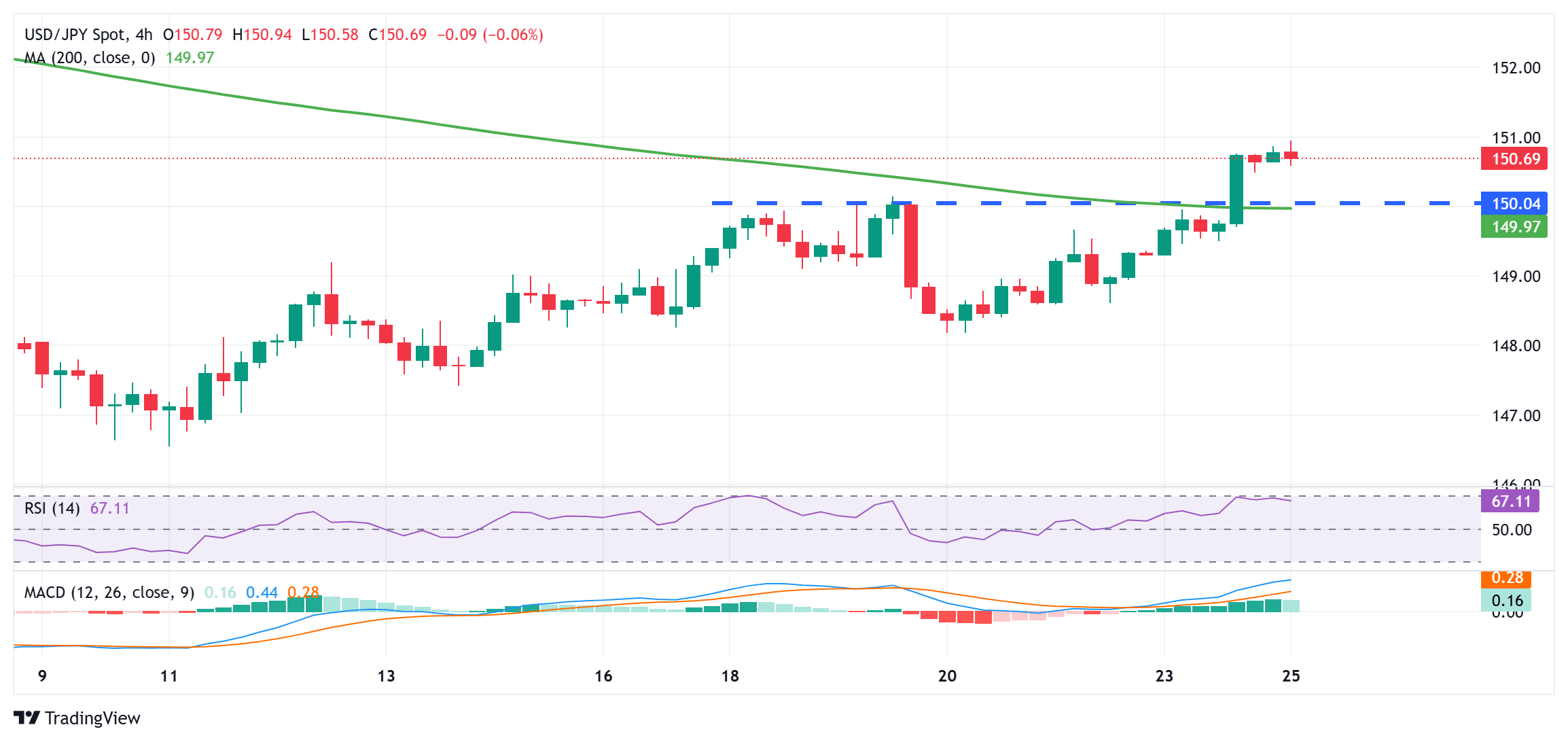Japanese Yen slides to three-week low against USD; lacks follow-through selling
- The Japanese Yen continues to lose ground as the risk-on mood undermines safe-haven assets.
- The USD stands near a multi-week high touched on Monday and also lends support to USD/JPY.
- The divergent BoJ-Fed expectations warrant caution before positioning for any further JPY losses.
The Japanese Yen (JPY) drifts lower against its American counterpart for the fourth consecutive day, pushing the USD/JPY pair to the 151.00 neighborhood, or a three-week top during the Asian session on Tuesday. The global risk sentiment remains well supported by hopes that US President Donald Trump's so-called reciprocal tariffs will be narrower and less strict than initially feared. Adding to this, the optimism over a possible Russia-Ukraine peace deal and reports that China is considering including services in the subsidy program to stimulate consumption further boost investors' confidence, undermining the safe-haven JPY.
Meanwhile, minutes of the Bank of Japan's (BoJ) January meeting showed that policymakers discussed under what conditions the central bank should raise interest rates further. The minutes, however, did not provide any clues about the likely timing of the next BoJ move and did little to impress the JPY bulls. Nevertheless, the BoJ's hawkish outlook still marks a big divergence in comparison to the Federal Reserve's (Fed) forecast for two 25 basis points rate cuts by the end of this year. This might hold back the USD bulls from placing aggressive bets and support to the lower-yielding JPY, which should cap gains for the USD/JPY pair.
Japanese Yen is undermined by receding safe-haven demand; BoJ rate hike bets help limit the downside
- Reports on Sunday indicated that US President Donald Trump is planning a narrower, more targeted agenda for reciprocal tariffs set to take effect on April 2, fueling hopes for less disruptive tariffs and underpinning the risk sentiment.
- Talks between the US and Russian delegations concluded on Monday, and the discussion was centered around trying to reach a Black Sea maritime ceasefire deal. According to Russian state media, RIA, a joint statement is expected on Tuesday.
- Financial Times reports that China is considering including services in a multibillion-dollar subsidy program to stimulate consumption, further boosting investors' confidence and driving flows away from the safe-haven Japanese Yen.
- The US Dollar climbed to a nearly three-week high on Monday in reaction to the better-than-expected release of the US Composite PMI – which rose to 53.5 in March from 51.6 in the previous month –and further lends support to the USD/JPY pair.
- Minutes of the Bank of Japan (BoJ) last policy meeting held in January showed most members agreed the likelihood of hitting the 2% inflation target had been rising. Moreover, policymakers discussed the pace of raising interest rates further.
- Meanwhile, BoJ Governor Kazuo Ueda said in the parliament on Monday that our policy purpose is to achieve stable prices and that the central bank will adjust the degree of monetary easing if the 2% inflation target is likely to be achieved.
- This comes on top of the growing acceptance that stronger wage growth could contribute to mounting domestic price pressures and keep the door open for more interest rate hikes by the BoJ, which should help limit further losses for the JPY.
- In contrast, the Federal Reserve signaled last week that it is likely to deliver two 25 basis points rate cuts by the end of 2025. Traders, however, are pricing in the possibility of three quarter-point rate cuts at June, July, and October meetings.
- Atlanta Fed President Raphael Bostic said on Monday that he anticipates slower progress on inflation in coming months and sees the central bank cutting benchmark interest rate only a quarter of a percentage point by the end of this year.
- Tuesday's US economic docket features the release of the Conference Board's Consumer Confidence Index, New Home Sales, and the Richmond Manufacturing Index. This, along with Fed speak, could influence the USD price dynamics.
- The focus, however, will remain glued to the Fed's preferred inflation gauge – the US Personal Consumption Expenditure (PCE) Price Index on Friday – due on Friday, which will drive market expectations about the future rate-cut path.
USD/JPY could aim to surpass the 151.00 mark and retest the monthly swing high, around the 151.30 region

From a technical perspective, the overnight breakout above the 150.00 psychological mark and a subsequent move beyond last week's swing high, around the 150.15 region, was seen as a key trigger for bullish traders. Moreover, oscillators on the daily chart have been gaining positive traction and support prospects for a further appreciating move for the USD/JPY pair. Hence, some follow-through strength beyond the 151.00 round figure, towards testing the monthly swing high around the 151.30 area, looks like a distinct possibility.
On the flip side, any corrective pullback might now attract fresh buyers near the 150.15 region, which should help limit the downside near the 150.00 mark. A convincing break below the latter, however, could drag the USD/JPY pair to the 149.30-149.25 intermediate support en route to the 149.00 round figure and the 148.70-148.65 horizontal zone. Failure to defend the said support levels will suggest that the recent recovery from a multi-month low has run out of steam and shift the near-term bias back in favor of bearish traders.
Japanese Yen FAQs
The Japanese Yen (JPY) is one of the world’s most traded currencies. Its value is broadly determined by the performance of the Japanese economy, but more specifically by the Bank of Japan’s policy, the differential between Japanese and US bond yields, or risk sentiment among traders, among other factors.
One of the Bank of Japan’s mandates is currency control, so its moves are key for the Yen. The BoJ has directly intervened in currency markets sometimes, generally to lower the value of the Yen, although it refrains from doing it often due to political concerns of its main trading partners. The BoJ ultra-loose monetary policy between 2013 and 2024 caused the Yen to depreciate against its main currency peers due to an increasing policy divergence between the Bank of Japan and other main central banks. More recently, the gradually unwinding of this ultra-loose policy has given some support to the Yen.
Over the last decade, the BoJ’s stance of sticking to ultra-loose monetary policy has led to a widening policy divergence with other central banks, particularly with the US Federal Reserve. This supported a widening of the differential between the 10-year US and Japanese bonds, which favored the US Dollar against the Japanese Yen. The BoJ decision in 2024 to gradually abandon the ultra-loose policy, coupled with interest-rate cuts in other major central banks, is narrowing this differential.
The Japanese Yen is often seen as a safe-haven investment. This means that in times of market stress, investors are more likely to put their money in the Japanese currency due to its supposed reliability and stability. Turbulent times are likely to strengthen the Yen’s value against other currencies seen as more risky to invest in.

